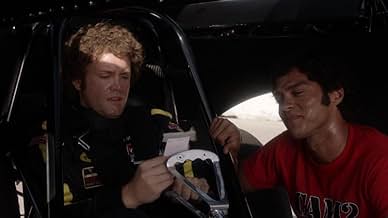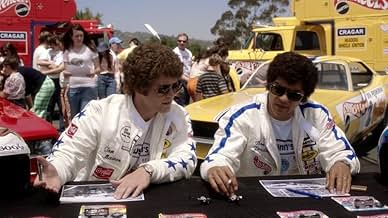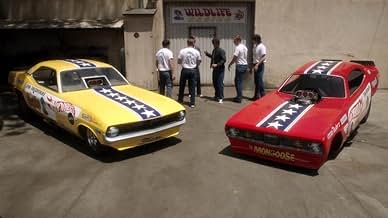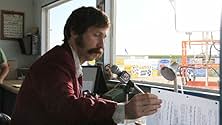Ajouter une intrigue dans votre langueThe untold story of how Southern California drag racers, Don "The Snake" Prudhomme and Tom "The Mongoose" McEwen combined with corporate giants to change the face of sports and ultimately be... Tout lireThe untold story of how Southern California drag racers, Don "The Snake" Prudhomme and Tom "The Mongoose" McEwen combined with corporate giants to change the face of sports and ultimately became the most famous rivalry in racing history.The untold story of how Southern California drag racers, Don "The Snake" Prudhomme and Tom "The Mongoose" McEwen combined with corporate giants to change the face of sports and ultimately became the most famous rivalry in racing history.
Histoire
Le saviez-vous
- Anecdotes(CAMEO) Midway through the film when the Snake and Mongoose pull up to the pits of a race track, they are greeted by two security guards who tell them they can park anywhere. The two security guards are played by the real-life "Snake" and the real-life "Mongoose".
- GaffesMultiple instances of the modern 3 amber bulb "Christmas Tree" shown, when during the time period this movie takes place (1958-1978), the 5 amber bulb "Tree" was used.
- ConnexionsReferenced in The Snake and Mongoose Chronicles: Episode 2 (2011)
Commentaire à la une
Racing Films
Snake and Mongoose
Genre: Drama Released: 2013 Director: Wayne Holloway Run time: 102 min Platform viewed: Google Movies Clichés: We're gonna need a montage My rating: Four Hartley's
We all know about Prost and Senna, Brock and Johnson, but what about Snake and Mongoose? One of the reasons I started exploring all the racing films out there was because I thought I might come across some stories or aspects of racing I'd never heard of before. 'Snake and Mongoose' is one of those stories. The film is based on the rivalry in drag racing between Don Prudhomme (Snake) and Tom McEwen (Mongoose). Their rivalry spanned decades as both drivers started racing in the 1960's with McEwen retiring in 1992 and Prudhomme in 2009. But this was not your normal rivalry, while there was competitiveness between the two they orchestrated their own nicknames and played on the rivalry to bring in more fans, more sponsorship and more prize money.
Before we get further into the film, I need to deal with something else that this film brought up, The International Motorsports Hall of Fame (IMHOF). I had never really looked into the IMHOF before but from the outset I assumed that the drivers in there would be of international heritage. How wrong I was, the IMHOF is a little bit like the "WORLD" series of baseball, which is based on the premise that America is already the best at baseball so therefore the finals of the American Series constitute the best series in the world. The IMHOF has inducted 148 drivers of which 121 are from the United States of America. Of the others 11 are from the UK, four from Italy, three from Brazil, then one each from Argentina, Australia, Austria, Belgium and Germany. Ferdinand Porsche is there but listed as being Austro Hungarian, Czechoslovakian and German. Astonishingly there are two New Zealanders making up a whopping 7.4% of the international contingent. They are Denny Hulme and Bruce McLaren who did a lot of sports car racing in the U.S.A. This should not really be news to anyone as the world is now well used to kiwis excelling in motor racing. Do I need to remind everyone that in 2020 kiwis have won the Supercars Championship, Bathurst, Le Mans 24hr, the Indy Car Championship and a team founded by kiwis came 3rd in the F1 constructors championship? Not good enough? Then what about Earl Bamber managing to finish first and second in the GTLM class at the 12 hours of Sebring? Needless to say, it has been a good year for kiwis...hopefully this has not gone unnoticed by IMHOF.
O.K digression over, let's get to the film. Knowing nothing of this story from the outset I thought this film did a great job of bringing it to life. Essentially this is a rivalry story with a twist, Prudhomme and McEwen were true competitors but also collaborators. The film takes us back to the early years of their careers in drag racing where Prudhomme is a conscientious grease monkey type character who likes to get his hands dirty and in contrast McEwen is a bit more of a party boy but also a bit of an entrepreneur. McEwen, however, is also smart enough to realise that the 'show' of motor racing is all about close competition and rivalry. Not only that, he can see the potential in marketing this rivalry. From here McEwen begins to create a marketable rivalry narrative including coming up with their respective nicknames.
As McEwen is not satisfied with the prize haul from his typical season running he starts marketing the 'Snake and Mongoose' show to drag strips around the country to support local track meets and boost the track gate takings. In return he bargains with track owners on a fixed payment to have them race which he splits with Prudhomme. The races not only attract more fans but also start to get the names 'Snake' and 'Mongoose' put out there more widely building national interest in the rivalry.
Building on the success of this McEwen approaches the head of Mattel toys who in 1968 had started producing Hot Wheels. The toys were already a kid favourite through producing some replicas of popular American street cars. McEwen's proposal to Mattel was that they could put Hot Wheels sponsorship on their drag cars and produce replicas of their cars to add to the Hot Wheels range. Mattel took some convincing but went along with the idea and as aresult Snake and Mongoose became the first drag racing team with corporate sponsorship. The partnership was a win for Mattel too with the Snake and Mongoose cars quickly becoming the biggest sellers in the Hot Wheels range in 1970. The two models initially produced were a Plymouth Barracuda and a Plymouth Duster funny car. Both models had hinged lift up bodies just like the real thing so you could see the huge engines and extra exhaust set ups underneath. Even by todays standards these models look awesome and Hot Wheels have gone on to produce various versions of these vehicles to this day. Earlier in 2020 Mattel put out some new reproductions of the cars to mark the 50th anniversary under their 'Legends of the Quarter Mile' branding.
Touring the country in this way mostly works out well but McEwen's party boy approach to life starts landing him in trouble on the home front. His wife finds it difficult to raise their son and confronts McEwen as he is about set off for another road trip. They separate which seems only to free up McEwen to pursue more of his off track activities. This then also leads to a falling out and split with his racing partner Prudhomme. McEwen is showing poor form and reliability on the strip which Prudhomme puts down to his off track activities impacting his ability to meticulously prepare his cars for racing. Another point of tension in the relationship had also been that Prudhomme was always more interested in racing top fuel dragsters as opposed to funny cars. So now he had a reason to split and pursue more of his own interests and goals.
Just as it seems like McEwen is in a destructive downward spiral, he learns that his only son has leukaemia. In the film this is shown as something of a turning point for McEwen. He starts spending more time with his son and contemplates withdrawing from racing altogether to support his family. His son has other ideas though and conveys to his father that watching him race was something he lived for and helped to keep him going through various treatments and long stints in hospital. This refocuses McEwen on his racing career, with renewed motivation McEwen beats Prudhomme to win the 1978 funny car nationals just a few days after his sons' death. It is a truly touching tale.
Overall this is an enjoyable film, the two main actors Jessie Williams (Prudhomme) and Richard Blake (McEwan) do an excellent job to authentically recreate the characters. Williams in particular bears an uncanny resemblance to a real life young Prudhomme. I was also totally captivated by Ashley Hinshaw as Lynn Prudhomme. She perfectly captured the 70s girl next door character but also the role of being a supportive partner helping Prudhomme with a lot of his work off the track. The acting is complimented by excellent recreations of the cars and clothing of the era creating a feeling of a time warp back to the 1970s. You should also keep an eye out for cameos from Prudhomme and McEwen themselves. This film captures a great personal story I never knew about and a racing story that produced one of sports longest running rivalries and changed the landscape of sponsorship in professional racing. We also get an epic montage thrown in put to Blue Oyster Cult.
In terms of its reception the film has a pretty average 5.7 rating on IMDB but I definitely felt that does not do the story or production quality justice. Don't be afraid to take a look at this film, while the subject of drag racing might not be your cup of tea, the story of these two racers is worth delving into. Prudhomme was also a significant campaigner for driver safety in drag racing, particularly fire protection, so as well as being the most successful driver ever he probably also saved some lives along the way. He is once quoted as saying "if we can send a guy to the moon, we can certainly go a quarter of a mile and not get hurt", wise words. This is where the Prudhomme and McEwen story ends up, a fitting showdown between IMDB and IMHOF. In this case IMDB have got it wrong, the film is worth more than it's 5.7 rating and IMHOF got it right, Don Prudhomme is well worthy of his inclusion, he just needs a few more international buddies.
© Copyright Racing Films
Snake and Mongoose
Genre: Drama Released: 2013 Director: Wayne Holloway Run time: 102 min Platform viewed: Google Movies Clichés: We're gonna need a montage My rating: Four Hartley's
We all know about Prost and Senna, Brock and Johnson, but what about Snake and Mongoose? One of the reasons I started exploring all the racing films out there was because I thought I might come across some stories or aspects of racing I'd never heard of before. 'Snake and Mongoose' is one of those stories. The film is based on the rivalry in drag racing between Don Prudhomme (Snake) and Tom McEwen (Mongoose). Their rivalry spanned decades as both drivers started racing in the 1960's with McEwen retiring in 1992 and Prudhomme in 2009. But this was not your normal rivalry, while there was competitiveness between the two they orchestrated their own nicknames and played on the rivalry to bring in more fans, more sponsorship and more prize money.
Before we get further into the film, I need to deal with something else that this film brought up, The International Motorsports Hall of Fame (IMHOF). I had never really looked into the IMHOF before but from the outset I assumed that the drivers in there would be of international heritage. How wrong I was, the IMHOF is a little bit like the "WORLD" series of baseball, which is based on the premise that America is already the best at baseball so therefore the finals of the American Series constitute the best series in the world. The IMHOF has inducted 148 drivers of which 121 are from the United States of America. Of the others 11 are from the UK, four from Italy, three from Brazil, then one each from Argentina, Australia, Austria, Belgium and Germany. Ferdinand Porsche is there but listed as being Austro Hungarian, Czechoslovakian and German. Astonishingly there are two New Zealanders making up a whopping 7.4% of the international contingent. They are Denny Hulme and Bruce McLaren who did a lot of sports car racing in the U.S.A. This should not really be news to anyone as the world is now well used to kiwis excelling in motor racing. Do I need to remind everyone that in 2020 kiwis have won the Supercars Championship, Bathurst, Le Mans 24hr, the Indy Car Championship and a team founded by kiwis came 3rd in the F1 constructors championship? Not good enough? Then what about Earl Bamber managing to finish first and second in the GTLM class at the 12 hours of Sebring? Needless to say, it has been a good year for kiwis...hopefully this has not gone unnoticed by IMHOF.
O.K digression over, let's get to the film. Knowing nothing of this story from the outset I thought this film did a great job of bringing it to life. Essentially this is a rivalry story with a twist, Prudhomme and McEwen were true competitors but also collaborators. The film takes us back to the early years of their careers in drag racing where Prudhomme is a conscientious grease monkey type character who likes to get his hands dirty and in contrast McEwen is a bit more of a party boy but also a bit of an entrepreneur. McEwen, however, is also smart enough to realise that the 'show' of motor racing is all about close competition and rivalry. Not only that, he can see the potential in marketing this rivalry. From here McEwen begins to create a marketable rivalry narrative including coming up with their respective nicknames.
As McEwen is not satisfied with the prize haul from his typical season running he starts marketing the 'Snake and Mongoose' show to drag strips around the country to support local track meets and boost the track gate takings. In return he bargains with track owners on a fixed payment to have them race which he splits with Prudhomme. The races not only attract more fans but also start to get the names 'Snake' and 'Mongoose' put out there more widely building national interest in the rivalry.
Building on the success of this McEwen approaches the head of Mattel toys who in 1968 had started producing Hot Wheels. The toys were already a kid favourite through producing some replicas of popular American street cars. McEwen's proposal to Mattel was that they could put Hot Wheels sponsorship on their drag cars and produce replicas of their cars to add to the Hot Wheels range. Mattel took some convincing but went along with the idea and as aresult Snake and Mongoose became the first drag racing team with corporate sponsorship. The partnership was a win for Mattel too with the Snake and Mongoose cars quickly becoming the biggest sellers in the Hot Wheels range in 1970. The two models initially produced were a Plymouth Barracuda and a Plymouth Duster funny car. Both models had hinged lift up bodies just like the real thing so you could see the huge engines and extra exhaust set ups underneath. Even by todays standards these models look awesome and Hot Wheels have gone on to produce various versions of these vehicles to this day. Earlier in 2020 Mattel put out some new reproductions of the cars to mark the 50th anniversary under their 'Legends of the Quarter Mile' branding.
Touring the country in this way mostly works out well but McEwen's party boy approach to life starts landing him in trouble on the home front. His wife finds it difficult to raise their son and confronts McEwen as he is about set off for another road trip. They separate which seems only to free up McEwen to pursue more of his off track activities. This then also leads to a falling out and split with his racing partner Prudhomme. McEwen is showing poor form and reliability on the strip which Prudhomme puts down to his off track activities impacting his ability to meticulously prepare his cars for racing. Another point of tension in the relationship had also been that Prudhomme was always more interested in racing top fuel dragsters as opposed to funny cars. So now he had a reason to split and pursue more of his own interests and goals.
Just as it seems like McEwen is in a destructive downward spiral, he learns that his only son has leukaemia. In the film this is shown as something of a turning point for McEwen. He starts spending more time with his son and contemplates withdrawing from racing altogether to support his family. His son has other ideas though and conveys to his father that watching him race was something he lived for and helped to keep him going through various treatments and long stints in hospital. This refocuses McEwen on his racing career, with renewed motivation McEwen beats Prudhomme to win the 1978 funny car nationals just a few days after his sons' death. It is a truly touching tale.
Overall this is an enjoyable film, the two main actors Jessie Williams (Prudhomme) and Richard Blake (McEwan) do an excellent job to authentically recreate the characters. Williams in particular bears an uncanny resemblance to a real life young Prudhomme. I was also totally captivated by Ashley Hinshaw as Lynn Prudhomme. She perfectly captured the 70s girl next door character but also the role of being a supportive partner helping Prudhomme with a lot of his work off the track. The acting is complimented by excellent recreations of the cars and clothing of the era creating a feeling of a time warp back to the 1970s. You should also keep an eye out for cameos from Prudhomme and McEwen themselves. This film captures a great personal story I never knew about and a racing story that produced one of sports longest running rivalries and changed the landscape of sponsorship in professional racing. We also get an epic montage thrown in put to Blue Oyster Cult.
In terms of its reception the film has a pretty average 5.7 rating on IMDB but I definitely felt that does not do the story or production quality justice. Don't be afraid to take a look at this film, while the subject of drag racing might not be your cup of tea, the story of these two racers is worth delving into. Prudhomme was also a significant campaigner for driver safety in drag racing, particularly fire protection, so as well as being the most successful driver ever he probably also saved some lives along the way. He is once quoted as saying "if we can send a guy to the moon, we can certainly go a quarter of a mile and not get hurt", wise words. This is where the Prudhomme and McEwen story ends up, a fitting showdown between IMDB and IMHOF. In this case IMDB have got it wrong, the film is worth more than it's 5.7 rating and IMHOF got it right, Don Prudhomme is well worthy of his inclusion, he just needs a few more international buddies.
© Copyright Racing Films
- racingfilmreviews
- 3 janv. 2021
- Permalien
Meilleurs choix
Connectez-vous pour évaluer et suivre la liste de favoris afin de recevoir des recommandations personnalisées
- How long is Snake & Mongoose?Alimenté par Alexa
Détails
- Date de sortie
- Pays d’origine
- Sites officiels
- Langue
- Aussi connu sous le nom de
- Snake & Mongoo$e
- Lieux de tournage
- Sociétés de production
- Voir plus de crédits d'entreprise sur IMDbPro
Box-office
- Budget
- 3 000 000 $US (estimé)
- Montant brut aux États-Unis et au Canada
- 152 200 $US
- Week-end de sortie aux États-Unis et au Canada
- 20 254 $US
- 11 août 2013
- Montant brut mondial
- 152 200 $US
- Durée1 heure 42 minutes
Contribuer à cette page
Suggérer une modification ou ajouter du contenu manquant

Lacune principale
By what name was Snake & Mongoose (2013) officially released in Canada in English?
Répondre
























